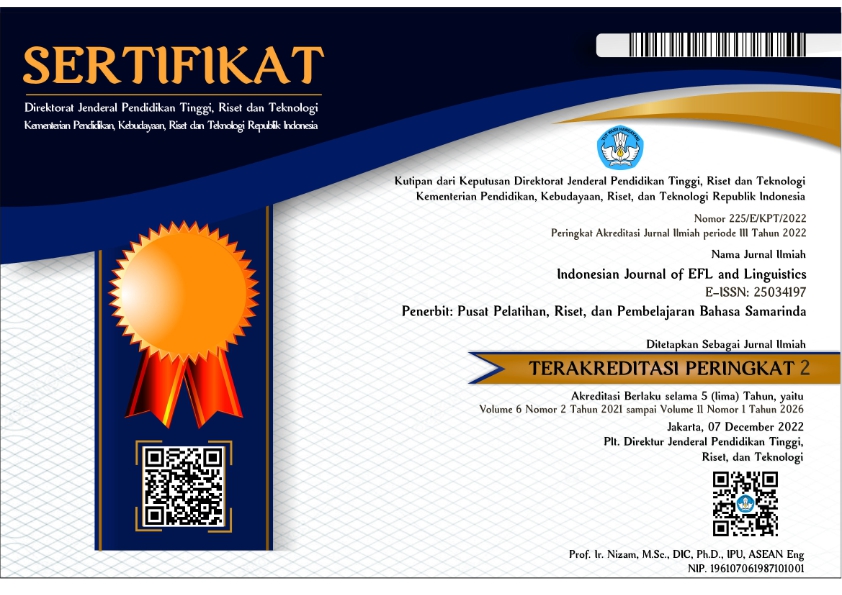Top-Up Students Second Language Talk Time through Vlogs
Abstract
In this technological era, students need a change in everything especially in learning a subject which is considered to be a difficult one for second language learners (SLL). The advent of internet at all levels of learning in the educational arena is a boon to English teachers to improve the communicative skills of students. This paper shows how Vlog (a fusion of video and blog) to be used in an English teaching classroom to improve students’ oral communication. Vlog helps students to practice English even outside the classroom, give instant teacher’s feedback about their performance and can watch fellow students’ performance. This paper discusses how teachers and students can very easily use vlog by understanding the computer mechanism. Keywords: teaching English, communicative skills, Vlog, teacher- student collaborationReferences
Benson, P. and Reinders, H. (eds) (2011). Beyond the Language Classroom. Basinstoke: Palgrave, Macmillian.
Brinton, D. M. (2001). The use of media in language teaching. In Celce-Murcia, M. (Ed.), Teaching English as a Second or Foreign Language (pp. 459-475). Boston, MA: Heinle and Heinle
Bryant, T. (2006). Using World of Warcraft and other MMORPGs to foster a targeted, social and cooperative approach toward language learning. Available at: htmp// www.academiccommons.org/commons/essay/bryant- MMORPGs-for SLA, [accessed 9/8/2016]
Dornyei, Z. (2009). The L2 Motivational Self System. In Dornyei, Z. and Ushioda, E. (eds) Motivation, Language Identity and the L2 Self. Bristol: Multilingual Matters, pp. 9-42.
Emery,H. (2012). A Global Study of Primary English Qualifications: Training and Career Development. London: British Council.
Froehlich, J. (1999). Language lab - Multimedialab - Future lab. In Hogan-Brun, G. & Jung, U. O. H. (Ed.), Media, Multimedia Omnimedia (pp. 149-155). Peter Language publishers, Frankfurt.
Lama, D. (2006). Using ICT to support young learners who are non-native speakers of English. IATEFL Young Learner Newsletter, 26-27.
Miller, J. (2003). Audible Difference: ESL and Social Identity. Clevedon: Multilingual Matters.
Murphy, J.M. (1989). Listening in a second language: Hermeneutics and inner speech. TESOL Canada Journal. 6(2), 27-44.
Myhill,D. (2006). Talk, talk, talk: Teaching and learning in whole class discourse. Research Papers in Education, 21(1): 19-41.
NCH Software. (n.d). Debut video capture software (Computer Software). Canberra, Australia. http://www.nchsoftware.com/capture/index.html
Scrivener, J. (2007). Learning Teaching (2nd edn). London: Macmillan.
Stern, H.H. (1983) Fundamental Concepts of Language Teaching. Oxford: Oxford University Press.
Throne, S.L., and Black, R.W. (2011). Identity and Interaction in Internet-mediated contexts. In Higgins, C. (ed) Identity Formation in Globalizing Contexts. New York: Mouton de Gruyter, pp. 257-278.
VideoLAN, (2012). VLC media player (Version 2.0.1.) [Computer Software[. Paris, France. http://www.videolan.org/
Walsh, S. (2002). Construction or obstruction: Teacher talk and learner involvement in the EFL classroom. Language Teaching Research, 6 (1): 3-23.
Brinton, D. M. (2001). The use of media in language teaching. In Celce-Murcia, M. (Ed.), Teaching English as a Second or Foreign Language (pp. 459-475). Boston, MA: Heinle and Heinle
Bryant, T. (2006). Using World of Warcraft and other MMORPGs to foster a targeted, social and cooperative approach toward language learning. Available at: htmp// www.academiccommons.org/commons/essay/bryant- MMORPGs-for SLA, [accessed 9/8/2016]
Dornyei, Z. (2009). The L2 Motivational Self System. In Dornyei, Z. and Ushioda, E. (eds) Motivation, Language Identity and the L2 Self. Bristol: Multilingual Matters, pp. 9-42.
Emery,H. (2012). A Global Study of Primary English Qualifications: Training and Career Development. London: British Council.
Froehlich, J. (1999). Language lab - Multimedialab - Future lab. In Hogan-Brun, G. & Jung, U. O. H. (Ed.), Media, Multimedia Omnimedia (pp. 149-155). Peter Language publishers, Frankfurt.
Lama, D. (2006). Using ICT to support young learners who are non-native speakers of English. IATEFL Young Learner Newsletter, 26-27.
Miller, J. (2003). Audible Difference: ESL and Social Identity. Clevedon: Multilingual Matters.
Murphy, J.M. (1989). Listening in a second language: Hermeneutics and inner speech. TESOL Canada Journal. 6(2), 27-44.
Myhill,D. (2006). Talk, talk, talk: Teaching and learning in whole class discourse. Research Papers in Education, 21(1): 19-41.
NCH Software. (n.d). Debut video capture software (Computer Software). Canberra, Australia. http://www.nchsoftware.com/capture/index.html
Scrivener, J. (2007). Learning Teaching (2nd edn). London: Macmillan.
Stern, H.H. (1983) Fundamental Concepts of Language Teaching. Oxford: Oxford University Press.
Throne, S.L., and Black, R.W. (2011). Identity and Interaction in Internet-mediated contexts. In Higgins, C. (ed) Identity Formation in Globalizing Contexts. New York: Mouton de Gruyter, pp. 257-278.
VideoLAN, (2012). VLC media player (Version 2.0.1.) [Computer Software[. Paris, France. http://www.videolan.org/
Walsh, S. (2002). Construction or obstruction: Teacher talk and learner involvement in the EFL classroom. Language Teaching Research, 6 (1): 3-23.
Published
2016-11-01
How to Cite
Anil, B. (2016). Top-Up Students Second Language Talk Time through Vlogs. Indonesian Journal of EFL and Linguistics, 1(2), 129-143. https://doi.org/10.21462/ijefll.v1i2.9
Section
Articles




